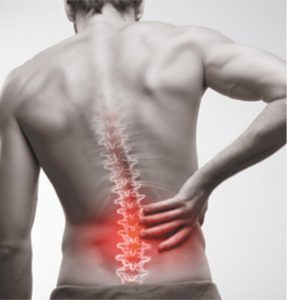Dr. Sunil Panchal
 When you’re dealing with chronic low back pain, it’s difficult to focus on anything other than your discomfort. The agonizing and sometimes debilitating pain can cause us to lose out on the important things, like spending time with our families, being productive at work, and even the simplest daily activities can require monumental strength to muster through them.
When you’re dealing with chronic low back pain, it’s difficult to focus on anything other than your discomfort. The agonizing and sometimes debilitating pain can cause us to lose out on the important things, like spending time with our families, being productive at work, and even the simplest daily activities can require monumental strength to muster through them.
The statistics are overwhelming. Millions of individuals that suffer from low back pain and are not getting the relief that they could simply because their condition is often misdiagnosed. One of the most widespread causes of low back pain known as sacroiliac joint instability demands a specially trained health care provider to diagnose and treat the condition.
Sacroiliac (SI) joint instability, also known as SI dysfunction is very often undiagnosed because most physicians are not trained in this ligament sprain or joint malalignment disorder. The sacrum is the bottom portion of the spine, and its L-shaped vertebrae are fused together. The Ilium are the two large bones on each side of the sacrum that form the pelvic region. Very often, this area is misaligned, and the joints are under extreme tension and/or are offset.
The Symptoms of SI Joint Instability:
• Pain with sitting, standing, lying down or walking
• Numbness or tingling
• Pain that permeates down the legs
• Sciatic pain
• Groin and hip pain
• Pain just under the tailbone
• Gait issues
• Constant pain
Sacroiliac Joint Instability Causes
The most common cause of SI dysfunction is injury or trauma. If you’ve been in an auto accident or fallen on your hip or buttocks, you may have sprained or misaligned your SI joint. Transition syndrome also causes SI issues.
Other causes of Sacroiliac joint instability are, no precise cause at all. Some individuals are uncertain of how they may have injured themselves or why they have SI joint pain, and it takes an expert to diagnose and treat their condition properly. For women, being pregnant can cause some issues with joint pain due to the hormonal release that causes the pelvic region to relax and stretch as it prepares to make room within the birth canal. Other issues that cause SI dysfunction are spine misalignment, stenosis, and leg length discrepancies to name a few.
Instead of masking the pain with addictive medications or undergoing risky, unnecessary surgery, Dr. Panchal, with the National Institute of Pain, has been offering patient’s real relief and a restorative effect for their SI dysfunction. His technique, methods, and experience are the answer that many individuals have been waiting for to alleviate their back pain.
For SI Joint Instability, Dr. Panchal performs the following techniques: radiofrequency denervation, regenerative treatments (as non-surgical options), and minimally invasive SI joint fusion.
The National Institute of Pain utilizes the most advanced, innovative methods from radiofrequency to spinal stimulation to treat pain from surgical complications as well as the following:
• Back and neck pain, including herniated discs, spinal stenosis, tumors and fibrositis.
• Cancer Pain.
• Neuropathic Pain.
• Complex regional pain syndrome (also known as reflex sympathetic dystrophy or RSD.
• Muscle and joint pain.
• Disorders of the nervous system, including shingles and trigeminal neuralgia (facial pain).
• Chronic abdominal pain and pelvic pain.
• Pain from traumatic injuries including auto accidents
• Pain associated with osteoporosis and vertebral compression fractures.
• Sports related injuries.
At the National Institute of Pain, they treat each patient individually, using the latest equipment and various innovative procedures to diagnose pain and determine your care needs. The National Institute of Pain’s President and Founder, Dr. Sunil Panchal, is a board-certified pain management physician.
Dr. Panchal has held leadership responsibilities in many professional societies, including the Committee for Pain Medicine for the American Society of Anesthesiologists. Dr. Panchal has authored and co-authored a number of abstracts, journal articles, and book chapters. He currently serves as an invited editorial reviewer for Clinical Researcher, Anesthesia and Analgesia, Pain, Pain Medicine, and the Clinical Journal of Pain. He previously served as Editor-in-Chief of the International Journal of Pain Medicine and Palliative Care and of Seminars in Pain Medicine. Dr. Panchal also served as the Chair of the National Comprehensive Cancer Network Cancer Pain Panel and has lectured widely at the national and international level. He is actively involved in the development of novel analgesics and neurostimulation devices, and in clinical research protocol design.
At The National Institute for Pain, their goal is to strive to deliver the highest quality of comprehensive care for those who are suffering from acute and chronic pain. They have many alternatives to help you with your personalized pain management needs. Please visit their website at www.nationalinstituteofpain.org or call them at (813) 264-PAIN (7246).
For appointments, you can also email appt@nationalinstituteofpain.org.
The National Institute for Pain
(813) 264-PAIN (7246)
www.nationalinstituteofpain.org
 Central Florida Health and Wellness Magazine Health and Wellness Articles of the Villages
Central Florida Health and Wellness Magazine Health and Wellness Articles of the Villages


